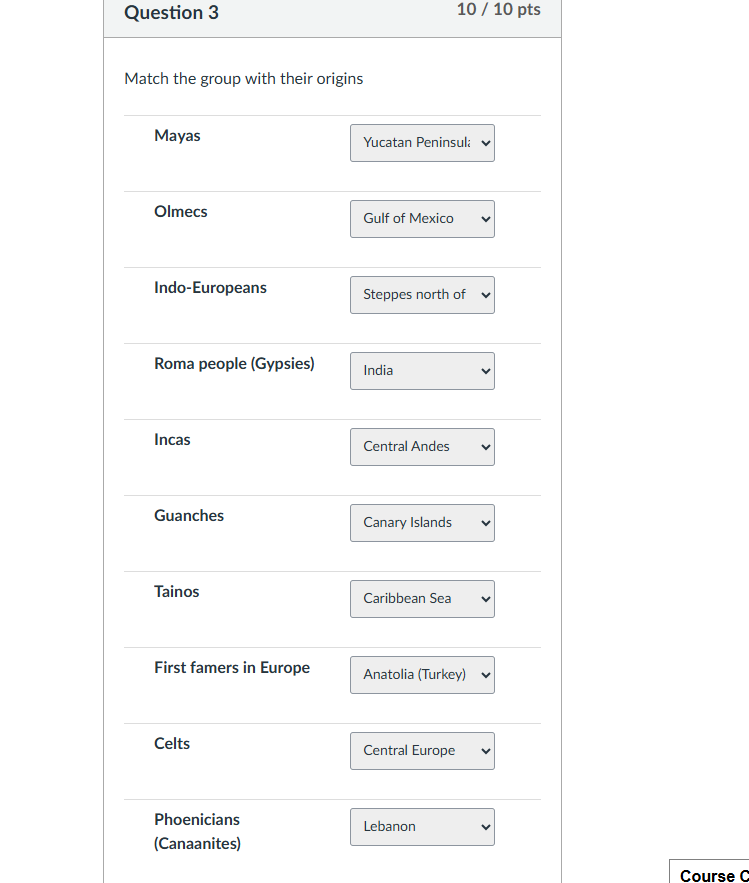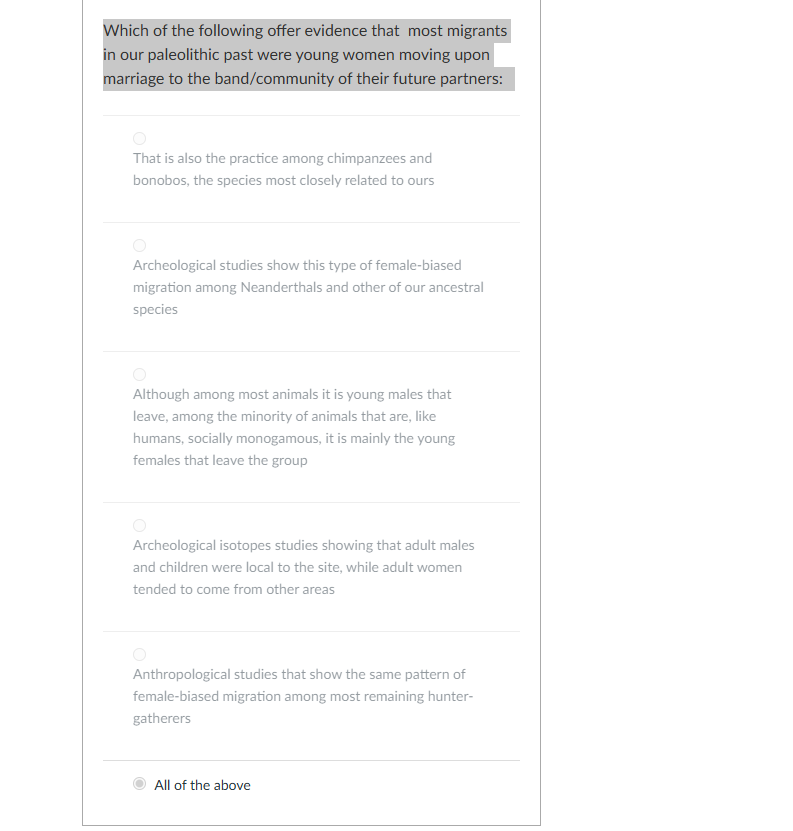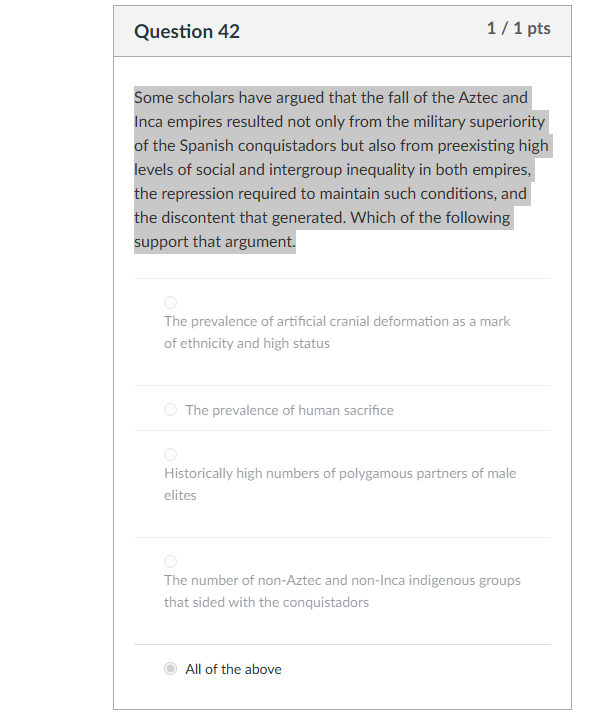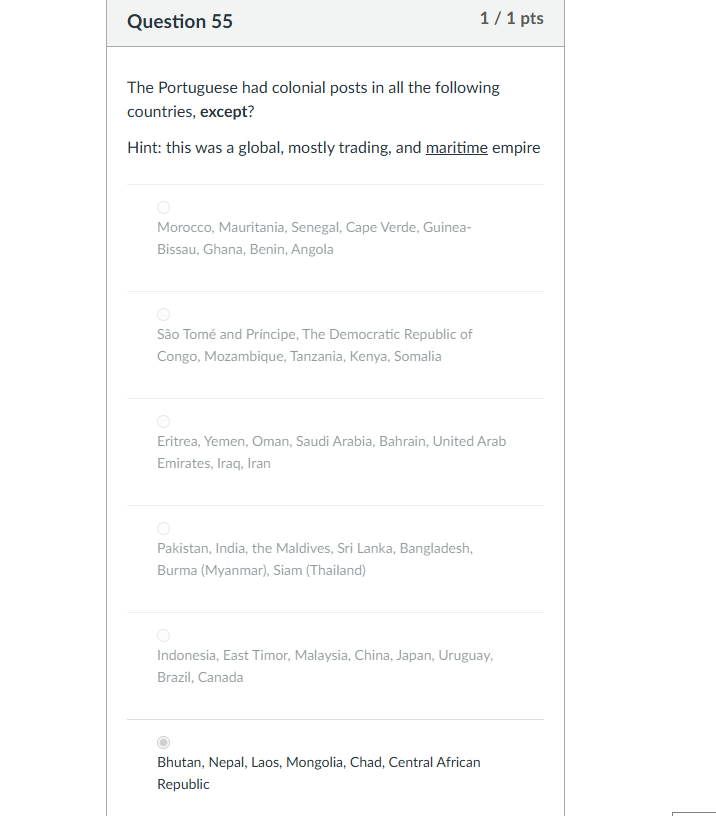Latin America Final
1/124
There's no tags or description
Looks like no tags are added yet.
Name | Mastery | Learn | Test | Matching | Spaced |
|---|
No study sessions yet.
125 Terms
Match the group with their origins

Rank the following social groups chronologically by matching them with the order in which they appeared in human history, 1-first, 2-second, 3-third, etc. The chronological order also tends to overlap with the size of the groups from smallest to largest.

Migration is all of the following except:
limited to primates
High levels of polygamy are associated with gender and social inequality. The highest levels have been found in:
The Inca Empire
How do we know that all humans today descend only from those that in our deep past moved from their own band/community and mixed with others?
Because those that did not move and mix died out at some point due to lack of genetic diversity
The largest group of soldiers in the conquest of the Aztec Empire:
Tlaxcalans
All of these offer evidence that humans first appeared in Eastern and Southern Africa, except:
Some of these fossils show remains of black/dark-brown skin
Which appeared last (i.e., most recently) among humans?
black and white skin color
Which one is not a Homo sapiens practice or trait?
Like in other primates, individuals who migrate to other communities consistently break connections with their natal group
Which of the following animals has the largest brain-to-body ratio?
humans
Last occupied by Homo sapiens (humans)
amazonia
The aboriginal languages of this region have the most phonemes (distinct units of sound):
South Africa
Which of the following offer evidence that most migrants in our paleolithic past were young women moving upon marriage to the band/community of their future partners:

All of the following offer evidence or indicate that humans peopled the Americas much later than the other continents, except?
Pre-Columbian censuses show small populations, indicating they had not been in the Americas that long
The only non-Indo-European language in Western Europe and probably the only remaining language of the region's aboriginal people:
basque
Human's ability to procure meats provided the nutrients necessary for the development of our disproportionally large brains. Which of the following was the earliest method that allowed us to procure those nutrients?
Scavenging carrion or carcasses
Which one of the following is true of the oldest mine in the world, found in Swaziland (today's Eswatini, South Africa) and dated as 43 thousand years old?
It mined hematite for red ochre used in burials, indicating some form of belief in an afterlife
Has been referred to as "humanity's first art studio"
Blombos Cave in South Africa
Because they lived mostly isolated from the rest of the world for 50,000 years, this group is the most different genetically from the rest of humanity
Sail ships that could tack, the compass, the mariner's astrolabe, cartography, steel, firearms, horses, and immunity to small-pox all help explain why Spaniards could conquer the Amerindian people and not the other way around. How many of these innovations or advantages originated in Spain
Which of the following was not known or used in the Americas before the European conquest?
wheeled vehicles
Originally from tropical America, this has become a major food staple in Africa:
manioc or cassava
Circa 1500, chiefdoms (settlements with levels of population density and political complexity greater than those of Neolithic tribes but lower than state-societies) could be found in what region of the Americas?
The northern and southern fringes of the Aztec & Inca empires
This group raided the Antilles, taking Taino women. The word cannibal derives from their ethnonym:
Caribs
Which did not exist in the Americas before 1492?
goats
What do tomatoes, chocolate, and avocados have in common?
the words all derive from Nahuatl
Some scholars have argued that the fall of the Aztec and Inca empires resulted not only from the military superiority of the Spanish conquistadors but also from preexisting high levels of social and intergroup inequality in both empires, the repression required to maintain such conditions, and the discontent that generated. Which of the following support that argument.

What is a Xoloitzcuintle?
An edible Mesoamerican hairless dog
Which animals were not introduced to the Americas by Spaniards?
Llamas, turkeys, guinea pigs
Which of the following was known in the Americas before the European conquest?
Calendar
What is not true of the Mayas?
Developed a relatively peaceful, egalitarian, and ecologically-sustainable society
The lack of Spanish and Portuguese creoles, and the high saturation levels of those languages in Spanish America and Brazil compared to the abundance of creoles and lower saturation levels in most of the rest of the postcolonial world is due mainly to:
The deep, culturally-transformative nature of Iberian colonialism in the Americas
This country has the largest population of African ancestry in the world outside of Nigeria and the largest population of European ancestry outside of Europe after the United States:
Brazil
What do Florida, Arizona, Nevada, Montana, Colorado, and California have in common?
spanish names
The century following 1492 saw all of the following except:
the beginning of the british empire
The Portuguese had colonial posts in all the following countries, except?
Hint: this was a global, mostly trading, and maritime empire

Spaniards brought all of the following plants or vegetables to the New World flora except:
Potatoes, tomatoes, corn, quinoa
What do Patagonia, the southern Pampas, the Gran Chaco, Amazonia, most of the US West, and most of Canada have in common?
The indigenous population remained independent during the entire colonial period
Only three legal racial categories existed in colonial Spanish America. Which was not one of them?
"Blacks" (whether they were free or enslaved)
Which is true of Iberian emigration to the Americas when compared to European emigration to other colonies before 1800?
Because of the opportunities in these rich colonies, the challenge for the Iberian kingdoms was not how to convince subjects to move to the American colonies but how to prevent so many from leaving
Roman colonization of the Iberian Peninsula resembles Iberian colonization of the Americas in all respects except:
It decimated the local population
How many universities had been founded in Spanish America by the time the first one was founded in the US around 1780?
27
The Visigoth conquerors of what is today Spain faced all of the following challenges in establishing their rule, except?
There were few women among them so they could not reproduce their culture
The relative number of French colonists in Algeria or of British and Afrikaner (Dutch) colonists in South Africa was similar to that of Spaniards and Portuguese in Latin America. Yet their cultural impact on the local societies never reached the level of that of Iberians in the Americas. The most likely reason for this was:
That they did not mix with the local population to the same degree
The Spanish philosopher Juan Ginés de Sepúlveda argued that war against Amerindians was just because they were barbarians, making all of the following points except?
That they were neither Christians nor white
Iberian colonization in the Americas led to much deeper and broader levels of Europeanization than European colonialism in Africa and Asia. Which is not a probable explanation for this?
European colonialism ended much later in the Americas than in Asia and Africa
All of the following had large black populations except:
Chile
Migration networks have all of these traits except:
Resemble a chain because they connect one individual only to another, and one destination only to the place of origin
Which is true of migration to the New World before 1800:
Three times as many people came from Africa as from Europe
It has the highest proportion of indigenous language speakers in its population:
Guatemala
Which among the following is the oldest marker of group identity and membership (also the one that appeared earlier in the history of our species)?
language
Which did NOT characterize the richest regions in the Western Hemisphere before the 1800s?
Majority of population was of European ancestry
The first university in the Western Hemisphere was founded in 1538 in what is today:
DR
Not among the Western Hemisphere’s 10 largest cities in 1790:
New York
Which was the largest city in the Western Hemisphere in 1800?
Mexico City
This term comes from the name of the peninsula occupied by Spain and Portugal and designates Spanish-America and Brazil:
Ibero-America
The century after 1830 witnessed all of the following trends except:
European and Euro-descendants became a smaller share of the world’s population
Has the lowest proportion of Afro-descendants in its population:
Bolivia
What do Patagonia, the southern Pampas, the Gran Chaco, Amazonia, and most of the U.S. West have in common?
The indigenous population remained mostly independent until the mid 1800s
Which was NOT among the twelve largest cities in the Western Hemisphere in 1900?
Mexico City
Term for runaway slave:
Maroon
The use of the term Malé to refer to Muslim slaves in Brazil originated in:
A Yoruba word meaning “the religion of the Malians”
African slavery in the Americas was exceptional, although not unique, in all the following ways except:
The importance of debt slavery
The proportion of free blacks in Iberian colonies was consistently, and at times dramatically, higher than in non-Iberian colonies. Which one of the following is least likely to explain this?
The religion of the Iberian Crowns
Specific African cultural elements in the Americas are most noticeable in Brazil and Cuba. Which of the following is the principal reason for this?
The two places received the bulk of the slave traffic during its last half-century
Most African slaves to the Americas were taken to:
The tropical or semi-tropical islands and coastal lowlands of the Western Hemisphere
The earliest comparative studies of slavery in the Americas argued all the following except:
The treatment of slaves was determined by economic interest rather than law or morality
The first country to abolish slavery (in 1804) in the Americas:
Haiti
Which was NOT true of Francisco Nunes de Moraes according to his will of 1811 included in the documents on slavery in Courseworks?
He rejected the Christian faith of his masters and remained true to his African Muslim beliefs
The last country to abolish slavery in the Americas:
Brazil
Which received the smallest number of African slaves?
Mexico
Around 1780, the proportion of the Black population that was free in this place was six times higher than in the other three, where over 95% of all Afro-descendants were enslaved. Which one was that place?
Brazil
Which one had the fewest slaves as a proportion of its population?
Spanish colonies other than Cuba
In his Autobiography of a Runaway Slave, Esteban Montejo mentions all of the following except:
That Chinese coolies could also fly back to China
Principal geographical source in Africa of the slave trade to the Americas:
The west coast between Senegal and Angola
Received the largest number of slaves:
Cuba
Working conditions for slaves were generally harshest in:
sugar plantations
According to the revisionist studies of New World slavery, which was the least important determinant of the relative harshness of slavery in the Americas?
The religious and legal traditions of the various European empires
Outside of Haiti, slaves’ responses to slavery included all of the following except:
Insurgencies that led to the abolition of slavery
Which were NOT among the twelve countries with lowest infant mortality in the world around 1900?
Germany, France, England
Had the second largest German overseas community after the United States:
Brazil
The Industrial Revolution in Europe fomented transatlantic migration in all the following ways except:
By impoverishing European workers
Origin of majority of Jews in Latin America:
Eastern Europe
Had the lowest mortality among the world's cities in the early 1900s:
Buenos Aires
Capoeira is:
A combination of martial arts and dancing
Which one of the following innovations in transportation and communications was NOT important in the upsurge of global migration during the 19th century?
automobiles and airplanes
The largest source of immigrants in postcolonial Latin America:
Italy
Manumission means to:
free slaves
British sailors, merchants, and migrants spread football (soccer) around the world. By 1900, these two cities had the largest number of football clubs in the world outside of London:
Buenos Aires and Montevideo
Which one was NOT true of chinos in New Spain circa 1565-1815?
Most went to what is today Peru
All are true of the Chinese in Cuba during the nineteenth century except
Came from all over China
Compared to European immigrants, all of the following characterized the experience of Jews and Lebanese/Palestinians in Latin America except:
Arrived earlier
Most Asian immigrants in colonial Latin America arrived through the trade route between these two cities:
Manila and Acapulco
All the following countries have had heads of state of Lebanese/Palestinian ancestry except:
the US and Canada
All are true of Japanese immigrants in Brazil except:
Have endured high levels of xenophobic violence
During the 20th century legal racial discrimination, as in the U.S., has existed only within this country:
Panama
The difference in the level of acceptance and integration of Japanese and Chinese and of West Indians and Haitians in Latin America shows that:
Racism is not just about physical appearance but also about social class, status, culture, gender, and political power
These two countries had the worst incidents of Sinophobic (anti-Chinese) violence in the Americas:
Mexico and Peru
In 1672 the Spanish Crown freed all Asian slaves in its American colonies because:
It classified them legally as Indians and Indians could not be enslaved
West Indian immigrants in Cuba enjoyed greater acceptance and success than Haitians. All of the following could explain this except:
Their lighter skin color
All of the following are true of Honduras’s black population except:
As elsewhere in Central America, it is concentrated on the interior highlands